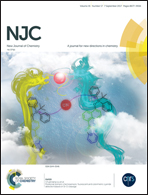Polyglycolide–montmorillonite as a novel nanocomposite platform for biosensing applications
Abstract
In catalytic biosensors, the immobilization of biomolecules in a suitable matrix is one of the vital parameters for obtaining improved systems. Clays, which are intercalated with various organic compounds, have a great tendency to develop biosensors with high stability, sensitivity and reproducibility. Herein, a polymer/clay nanocomposite based on natural silicate montmorilonite (Mt) and a biodegradable polymer polyglycolide (PGA) was prepared and characterized by FT-IR, thermogravimetric analysis, differential thermogravimetric analysis and X-ray diffraction. Then, the resulting matrix was used as a fixation matrix for pyranose oxidase (POx), which was selected as a model enzyme. The bioactive layer was fabricated by immobilization of POx on glassy carbon electrodes by means of PGA–Mt and bovine serum albumin. The POx biosensor revealed a good linear range from 0.01 to 0.5 mM glucose with a LOD of 1.2 μM. After the optimization of the working and preparation conditions, characterization studies were performed for glucose detection. Finally, the PGA–Mt/POx biosensor was confirmed to have detected glucose in beverages without needing any sample pre-treatment.



 Please wait while we load your content...
Please wait while we load your content...